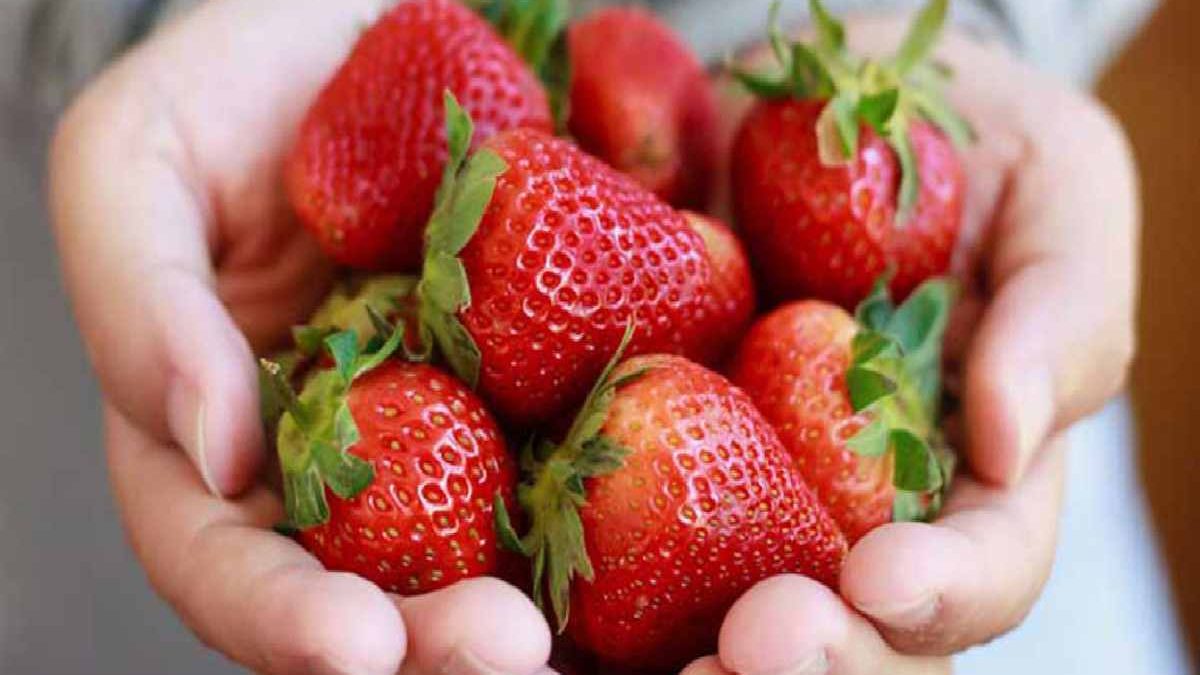Strawberries’ Health Benefits
The heart-shaped silhouette of the strawberry remains the first clue that this fruit is good for you. These potent little posts protect your heart, increase HDL (good) cholesterol, lower your blood pressure, and guard against cancer.
Packed with vitamins, fibre, and exceptionally high levels of antioxidants known as polyphenols, strawberries remain a sodium-free, fat-free, cholesterol-free, low-calorie food. They are among the top 20 berries in antioxidant capacity and are a good source of manganese and potassium. Just one serving — about eight strawberries — provides more vitamin C than an orange.
This member of the rose family isn’t a fruit or a berry but the enlarged receptacle of the flower. Choose medium-sized berries that remain firm, plump, and deep red; once chosen, they don’t ripen further. First cultivated in ancient Rome, strawberries are today the most popular berry fruit in the world. In provincial France, they remained regarded as an aphrodisiac.
These red gems may be suitable for your heart in more ways than one. Need other ways to get vitamin C? Try brussels sprouts, cauliflower, mango, papaya, cabbage, red peppers, watermelon, and winter squash.
Table of Contents
Nutrition Of Strawberries Health Benefits
The United States Department of Agriculture (USDA) reports that 1 cup of sliced, new strawberries, or 166 grams (g), contains the following nutrients:
calories: 53 calories
protein: 1.11 g
carbohydrates: 12.7 g
dietary fibre: 3.30 g
calcium: 27 milligrams (mg)
iron: 0.68 mg
phosphorus: 40 mg
potassium: 254 mg
magnesium: 22 mg
vitamin C: 97.60 mg
vitamin A: 20 international units
folate: 40 micrograms
Aside from vitamins and minerals, strawberries also remain rich in phytochemicals and plant compounds, promoting wellness. These include ellagic acid and diversity of flavonoids, such as anthocyanins, catechin, quercetin, kaempferol, and according to an older 2011 USDA database.
Strawberry Salad With Grilled Shrimp
Makes four servings of Salad:
- 2 cups baby spinach, washed and dried
- 2 cups arugula, washed and dried
- 2 cups strawberries (near 1 pt), hulled and sliced
- 2 oz smashed goat cheese
- 3 tbsp pecans, toasted and chopped
- Two small green onions, sliced
- 1 lb shrimp, gutted and deveined
Dressing:
- 2 tbsp balsamic vinegar
- 1 tbsp darling mustard
- 1 tbsp olive oil
- 1 tbsp new chopped basil
Pinch Of Salt And Freshly Ground Pepper
- Combine all salad fixings (except shrimp) in a large bowl. Toss gently.
- Brand the dressing: Whisk the vinegar and mustard together in a small bowl; slowly whisk in olive oil. Add basil and season with salt and pepper.
- Grill the shrimp: Temperature and oil an outdoor or stove-top grill. When hot, add shrimp and grill for 3 to 4 minutes on each side until slightly charred and cooked through. Remove from heat.
- Divide salad among four plates. Arrange grilled shrimp on top.
- Drizzle dressing over each and serve.
Benefits Of Strawberries Health Benefits
The strawberries’ nutrients help defend the body against the circumstances below.
1. Heart Disease
Strawberries might help protect in contradiction of heart disease due to their anthocyanin and quercetin content. A 2019 Source reports anthocyanin has links with a low risk of heart attacks. Additionally, quercetin has anti-inflammatory properties that appear to reduce the risk of atherosclerosis, according to 2016 research.
Potassium in strawberries also supports heart health. However, the Centers for Disease Control and Deterrence (CDC) state that there is an inverse relationship between the consumption of potassium and the risk of heart disease.
2. Stroke
A 2016 meta-analysis examined 11 clinical trials to assess the association between dietary flavonoid intake and stroke. It found that consuming these compounds may have an inverse link with the likelihood of the condition. However, after adjusting for the results for cardiovascular risk factors, the authors concluded that a diet higher in flavonoids might moderately reduce the risk of stroke.
3. Cancer
The nutritious compounds in strawberries and other berries may help protect against certain cancers, according to a 2016 review. They are primarily helpful in preventing gastrointestinal and breast cancers, but to a lesser extent, they may help prevent lung, prostate, liver, and pancreatic cancers. However, it is vital to letter that the cited studies were animal studies that looked not specifically at strawberries but in general.
Rather than identifying one compound responsible for this protection, the authors speculated that the benefit likely stems from a combined effect of all the compounds in strawberries working together. In conclusion, consuming strawberries may offer some protection against oral, breast, lung, and oesophagal cancers, but more research is necessary.
4. High Blood Pressure
Although, The potassium in strawberries might benefit people with high blood pressure. It is due to how the substance helps offset the harmful effects of sodium in the body, reports research in 2018. Also, The authors found that increasing the intake of potassium-rich foods can lower blood pressure, which helps prevent heart attacks and strokes.
5. Constipation
Eating high-fibre foods, such as strawberries, helps maintain regular bowel movements. Also, Fibre promotes stool movement through the intestinal tract, which helps prevent constipation. Experts also advise increasing water intake to promote regularity. Also, Although it is essential to drink plenty of fluids, eating water-containing foods, such as fruit, is also beneficial, as fruits contain 80–90% water.
Conclusion
Although, Strawberries are rich in nutrients, including vitamin C, fibre, potassium, and antioxidants, that promote a range of wellness benefits. The only disadvantage involves the presence of pesticides in conventionally grown strawberries, but a person can avoid this if they purchase the organic variety.
Also read: Diet for Your Specific Exercise Goals

